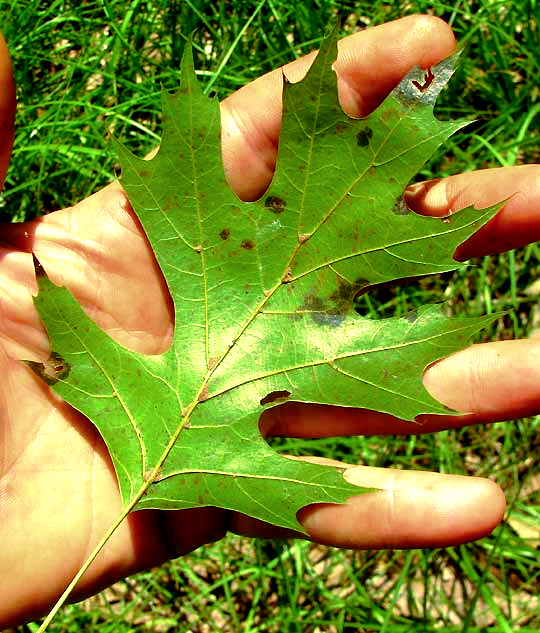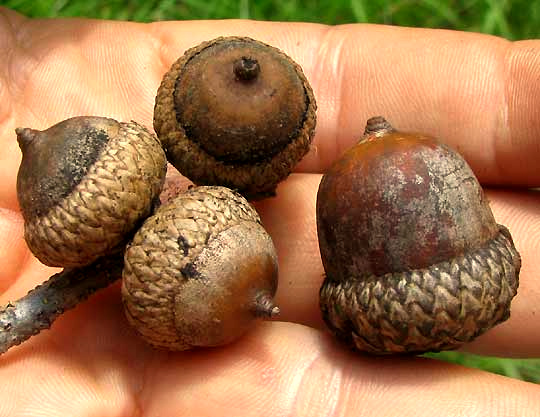Excerpts from Jim Conrad's
Naturalist Newsletter

from the June 17, 2012 Newsletter issued from the woods of the Loess Hill Region a few miles east of Natchez, Mississippi, USA
SHUMARD OAK'S DOMATIA & THICK ACORN CUPS
On the steep, moist sloped of a deep ravine cut into our thick covering of loess here certain large, pleasingly formed oaks have been a challenge to identify. You can see a high branch bearing bristle-margined leaves above. The shiny, hairless undersurface of one of its leaves is shown below:

Several oak species bear leaves of this general shape and size, but most have hairy leaf undersurfaces. Only two species, the Shumard and Nuttall Oaks, bear leaves with hairless, or glabrous, leaf undersurfaces. Those two species are so similar that I'm not sure I could distinguish them using only vegetative characters. While examining the leaf in the above picture hoping for distinguishing field marks, you might notice the unusual thick tufts of light-brown hairs in vein axils along the midrib, as seen up close below:

Those are called domatia and often are used by mites for shelter and as sites for egg-laying. Notice how the domatia are open in the center, perfect for a tiny mite to back into and be partially protected. Mites using such domatia often feed on invertebrates or fungi that might damage the host tree. It's a classic mutualistic relationship. Unfortunately, leaves of both the Shumard and Nuttall Oaks provide them.
Fortunately, the oaks are treated in the free but only partly completed online Flora of North America, and there is a technical "key" for identification purposes. In the key, the two species "key out" together -- indicating their very close relationship -- and are separated on the basis of differences in their acorn cups. Acorn cups are those scaly, saucer or bowl-shaped receptacles subtending the oval acorn nut. The cups of Nuttall Oak acorns are described as less than 1.5 mm in cross section, and their inner surfaces are hairy; the cups of Shumards Oak acorns are more than 1.5mm thick, and are hairless inside, or with only a ring of hairs around the scar. Happily, beneath the oaks in our ravine plenty of last year's acorns remain, some of which are shown below:

Breaking a cup apart, I find its wall thickness averaging about 3 mm, and I see no hairs. Therefore: Shumard Oak, QUERCUS SHUMARDII.
I had leaned toward this species, because the habitat description in Flora of North America is described as moist, protected slopes like our ravine slopes, bottomlands, stream banks and poorly drained uplands. The habitat of Nuttall's Oak, Quercus texana, is described as flood plains and bottomlands, with no mention of upland slopes. However, I have noticed that our loess soils don't fit the usual soil characterizations, so in this area I don't trust habitat descriptions as much as in some places.
Shumard Oak is mostly restricted to the US Southeast, though it's found as far north as northern Ohio and Missouri. With its large acorns it contributes greatly to local wildlife.
from the December 22, 2002 Newsletter issued from the woods of the Loess Hill Region a few miles south of Natchez, Mississippi; elevation ~200ft (~60m), ~N31.42°, ~W91.41°; USA
SHUMARD OAK
This is exactly the time of year to pay attention to oaks because they still bear their leaves and their acorns are fully formed, often to be found on the ground beneath the trees. If you like to walk through the woods identifying your trees, you probably know that the subject of "oaks" can be a messy one. Here's why:
Here at Laurel Hill I've identified nine oak species and there may be one or two others hiding. Four of those species possess deeply lobed leaves, and the lobes end in sharp, needlelike, "bristle" tips, so the leaves of those four species can look a lot alike. The look-alike species are:
At this time of year the least common of the above four species, the Shumard Oak, is easy to pick out in the forest, and during this week's warm, sunny afternoons I've relished walking through the woods locating them. On such days Shumard Oaks show up as large, yellow-leafed trees with a certain airy, glossy look.
Of course the leaves are yellow only in late fall. They look "airy" because their leaves are very deeply lobed and the lobes are narrow, so more light passes through the branches than with other trees. The "glossy" look results because the undersurfaces of Shumard Oak leaves are hairless, and therefore a bit shiny. The other deeply lobed, bristle-tipped leaves are usually covered below with thin layers of velvety hairs which from a distance give the trees dull, ashy looks, not glossy. However, late in the season sometimes leaf hairs wear off, so "leaf hairiness" isn't always a dependable character. That's why it's so nice to have acorns available.
You know that the nut part of an acorn is produced atop a scaly "cup." Well, Shumard Oak acorns have "flat cups," while the cups of acorns of the other deeply lobed, bristle tipped species are much deeper, more like goblets.
Shumard Oaks are "programmed" by their genes to play a specific role in the development of the forest around them. The species' seedlings need full sunlight. This means that Shumards "help heal" a forest when it is damaged and light floods through its broken canopy. Once the forest is mature, then the Shumards selflessly disappear from the scene because their seedlings can't survive the healed forest's shade. At Laurel Hill, Shumards have had it easy because the forests here have a long history of being logged and relogged.